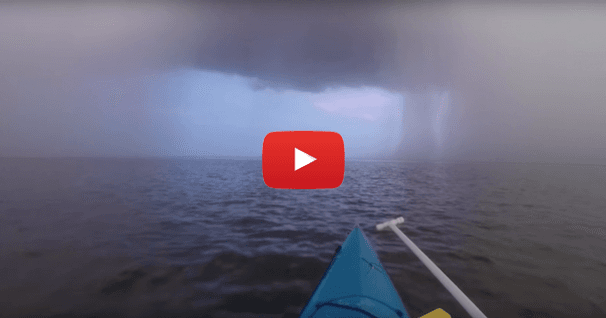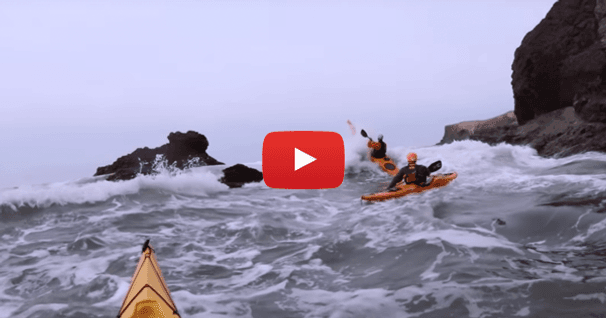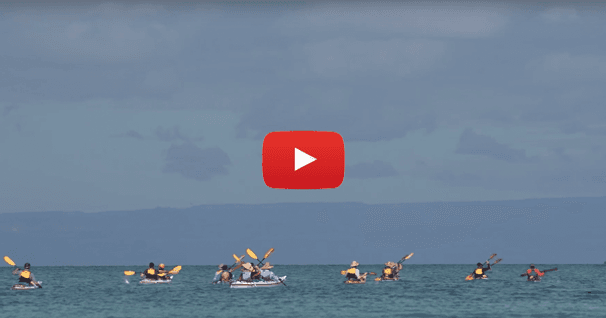10 Tips For Paddling With A Group
Here's a list of ten tips that I found useful when paddling with different groups.
Paddling group dynamics are very interesting and they vary from group to group. I thought I'd compile a bunch of tips that have worked for me in the past as I discovered how each group got along and how each group enjoyed being on the water.
What Type of Paddling?
The first thing I always like and appreciate whether I'm the group leader or someone else is the group leader is if there's the definition to what the paddle is going to consist of. Is it going to be an all-day leisurely paddle? Is it going to be a short leisurely paddle? Is it going to be a training day in rough conditions?
Pretty much everyone in the group will know exactly what they're in for before they show up to paddle. They know how to dress, they know what food to bring, they know how much water, they know who to call if they want to invite anybody else. That also goes with level of paddling experience.
A lot of times groups will say well if you want to join us for this group you need to know this, this and that, or you need to have at least these kinds of rescues down, or this is going to be a training session. It's good to define those things before the trip happens.
Check Everyones Skirt Pull Tabs
This next one applies if you're paddling with a group that uses spray skirts. This is something that I like to do all the time and I like to pass on to newer paddlers as well because it's very easy to make the mistake, and that is, to look around before you set off that everybody in your group has their pull tabs on their skirts outside of the cockpit.
It's very easy to make the mistake of keeping it tucked in. Just look around and make sure everybody's tab is out so that it's easy to pull the skirt out. It's not crucial for safety because you can get a skirt off the coaming without the pull tab, but it could be a very scary moment if you're upside-down and you go for the pull tab and it's not there.
I just find it to be a reassuring thing and it's easy enough to do. I just look around and make sure that everybody's tab is out before setting off.
Check Everyones Hatches
Along with skirts and pull tabs, same thing goes for hatch covers. When we were getting trained and getting our certification our instructors would go and pop our hatches anytime we were taking a break or we were having lunch, so that we wouldn't notice, get back on the water, do a rescue, capsize or do an exercise and all of a sudden our hatches would be filled with water. One of the things we got used to doing is every single time you go back on the water check that all of your hatches are nice and sealed.
It's very easy to miss them. I still miss them from time to time. If you're on the water, you pull something out quickly, you're taking a sandwich or maybe sun block, or when you're on the beach you remember you need to change the battery on your camera, and then you forget to seal your hatches completely. Of course this will only apply if you're paddling with a group that has sealed hatches, but a lot of kayaks nowadays have sealed hatches so I think this applies. Emptying out a hatch full of water is a pain if you're on the water doing a rescue, so it's just so much easier look around and check your hatches. Ask around, make sure everybody's good and then set off. It's also good to look while you're on the water at other people's hatches as well.
Communication (Visual and Technological)
This next one I found very important, and it changes so much from group to group, and that is communication. Hand signals and communication devices. You need to discuss all these things the moment you join a new group. Everybody has different hand signals. There's a couple of signals that are kind of universal. A lot of times people will say if you tap your head that's asking “are you okay?” and then you tap again to say “yes, I'm okay”, or using a paddle to hold it up in the air straight up means usually come to me, holding a paddle overhead across usually means stop or stay in place.
Different groups have different signals, so it's always good to figure these out ahead of time so that when you're on the water, if something happens you don't have to try to figure out what people are saying. That even starts with having communication devices as small as having a whistle on your PFD, which everyone should have because if someone is a little bit further away from you and they're not able to hear you but something happens to you or someone near you, you can easily blow the whistle to get people's attention and then get help. But then that goes a step further depending on the type of paddling you're doing.
My group always carries VHF radios and then most groups that I join while sea kayaking usually have VHF radios. Every group seems to use one of the many leisure channels, but you need to figure out which channel ahead of time. Even if you don't think you might be using the radio all day, it's always good to at least talk about it beforehand. “Are we on channel 68, channel 69?” or whatever leisure channel is in your particular area. Discuss it ahead, put that into your radio, put it away and you're good to go.
TAHE 10'6 & 11'6 SUP-YAK Inflatables
2-in-1 Kayak & Paddle Board complete packages for single or tandem use.
Knowledge of Groups Health Conditions
Now, this next topic could be a little touchy but I think it's very important. And that is any health concerns. And what I mean is, a lot of times we want to keep health concerns private, but when you're paddling, depending on the level of paddling you're doing, you're essentially having a group that's going to be taking care of you if something were to happen to you on in a remote place, or while you're on the water, or let's say you're surfing or you're in rough conditions. If there is a health concern, they need to know about it so that they can help you if something does happen. Things like: do you have any injuries? Do you have any recent injuries? Are you a diabetic? Do you have asthma? Do you have any specific allergies, let's say to peanuts? and if so, do you have an EpiPen with you and where is it in case something happens when you're on the water?
A lot of times the way to do this is if there's a group leader you can share those things in private with them and then they are able to assess and know when to share the information with whoever is taking care of you at that moment if needed, so that it can still remain private. But whoever's in charge of safety of the group has that in consideration. That might be a big part of decision-making. Let's say they see or they hear that a storm is coming, and they need to make a decision: do we make this crossing? or do we turn around at this time? and then we might have someone in the group that cannot be out for that many more hours - they need to make a decision according to that new information, and if you don't share that information they might make the wrong decision and not help you in the process.
If you're paddling with a group of friends, then there's no big deal in them knowing something like this because we're all really just taking care of each other while out on the water.
Delegating Responsibilities
This next tip is going to trickle down into the next couple that are going to all roll up to the same one, and that's delegating responsibilities. When we were getting trained to become instructors we did this all the time because when you are a group leader and you have to take care of a group of people you can't be everywhere at once. You can't remember to do every single thing, and I've been actually applying this idea of delegating anytime I’m on the water either with a group or with just friends because that way you can have a lot more coverage on what's happening in the group without having one person having to do it all.
Headcount
The first one that is very important, I do this one no matter what and that's headcount. It's very, very easy to misplace a paddler or two or three when you are in a big group. It's so quick, especially if they're swell and people are coming in and out of view, or if there's waves, or if there's a lot of wind and you're just pushing to try to get through, it's very easy to not look back for a little while or not to look to the sides or someone goes behind that some kind of obstruction and then you don't see them anymore.
Headcount is really important and it's always good to have someone in the group, whether it's you or someone else ahead of time to say “alright who's going to keep track of headcount today? Alright, great” and then get out on the water, make sure the numbers are kept the entire time.
Timekeeping
The next tip is also good to be delegated and that's timekeeping. Whether if it's for safety, or just if there's a certain time everybody needs to get back, or just to keep track of tides and currents because you know that there's certain areas that you can only cross, or you can only use certain types of currents in your favor. The easiest way to keep an eye on the time is by having someone in the group that's going to be taking care of that all day.
That's great if you're navigating somewhere and you have certain times that you need to get to certain places, but that also spills into common courtesy where if you're planning a paddle and you say “okay, let's go out on the water for two hours” and then you're not keeping track of the time but people have to go, it's nice if paddlers have those kinds of limitations for that day to have someone that's keeping an eye on the clock so that it's a little bit easier for people to speak up within a group. “Hey guys, we really should wrap up this lunch and get going because some of us need to be back in time.”
Bring Extra Gear/Supplies
The next one could also fall into delegation, but it might just depend on the group that you paddle with. That is bringing extra stuff to a group. So be it food, water, gear, clothing, etc. With my group, we kind of know who's going to be bringing extra stuff because they just always bring extra all the time. My buddy Felix, he always shows up with extra everything. He'll always have a nice big thermos of warm tea. and he'll bring stuff to make coffee on the spot all the time. That's just who Felix is.
I don't care what group I'm paddling with, I always bring extra clothes in extra-large size just in case someone goes in the water, I know that I have something to put on them.
Another thing that I think is very important to bring is extra water, especially on hot sunny days. Same thing goes for food. I always bring a little bit of extra food. It’s very easy to forget our lunch or breakfast packed in the car. Not only is it something nice to do, you need to keep the group's energy up.
Also, within group paddling dynamics, a lot of times people will just a shrug it off and say “no, it's okay I'll wait till later” or “no, it's okay, I'm not really that hungry” because maybe they were embarrassed that they forgot their food or they forgot their water, and so we want to make sure that you're hydrated and you're fed. You're part of the group and we don't want someone to not feel well and not be able to paddle because they forgot something back at the car or back home. Here. Everybody eat up, everybody refreshed? Great, let's go.
Ability to Check-In
The last one for this list is very important to me and that is if people within your group need to turn back early, having some kind of system so they can check in and let you know that they're safe. Whether it is through a text, whether it is the moment they're back, they're going to send a note or an email or they're going to check in with the VHF radio if they're still in distance to let you know that they're back safe. Always knowing if people are indeed going to turn around and head back. Not just to turn around and head back without letting the rest of the group know. We always have to have that information so we know exactly what's happening to everybody within the group. Headcount, right? The last thing you need is for a couple of people within the group to have just turned around, and went back without the rest of the group knowing that's happening. This is to be sorted out beforehand so that everybody knows what's going on, and then of course, having some way to check in.
So those are ten tips that have helped me when paddling with different groups. All of these things come into play in group dynamics. So if you have anything to add, do you do something different with your group? Please comment below, I'd love to hear it. If you have any questions, please comment as well. Subscribe if you'd like, I'm always trying to put these videos out. I hope that was helpful, as always, Luke Rovner for Kayak Hipster, thank you for watching and see you next time.
Related Articles
Even if you do your research and check the weather before heading out, sooner or later every kayak…
When a situation occurs while paddling in a group, conditions don't stop. Learn some pointers on how to…
Whenever you're paddling, there's safety in numbers and so it's generally not a good idea to paddle…
A discussion on the use of a compass from a kayaking standpoint begins with basic compass savvy and then…




